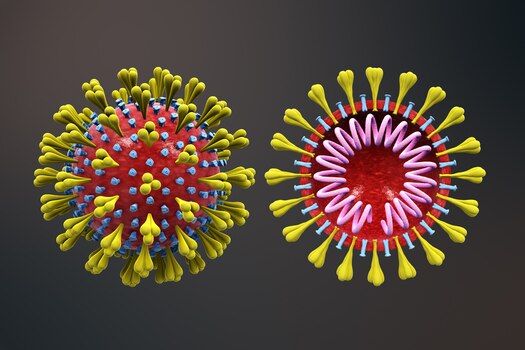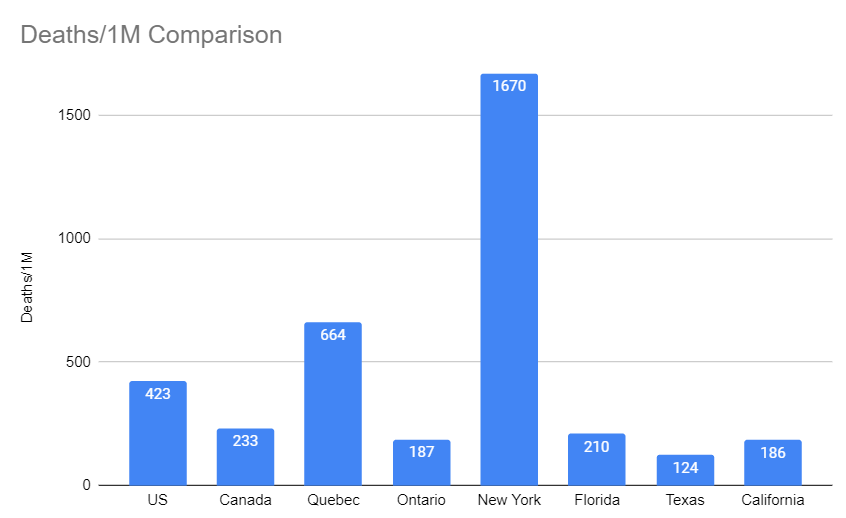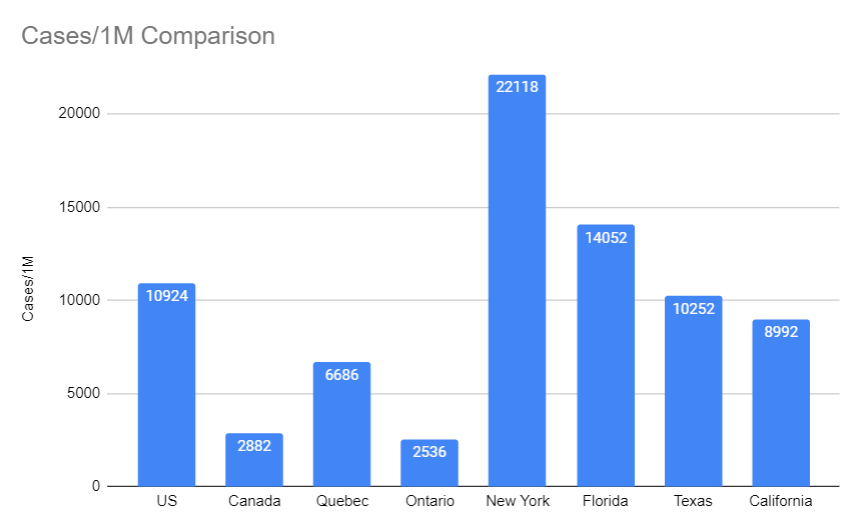
Herd Immunity - Does the US Have the Right Idea?
Time for a post full of numbers! I wanted to give a perspective on what's happening internationally, especially in the US since there is so much focus on them right now, much of it very negative. Remember, the main thing that ultimately matters is deaths. If everyone get the virus and no one dies, that's a good thing! Conversely, if only 100 people got the virus but they all died, that's a bad thing. I make this simplistic point because so much focus on the US is on the large spike in cases they are seeing now, but unless that's correlating with record levels of death, then perhaps it's a whole lot of noise in the media for nothing. Let's dig in.
In the one month period from April 7 to May 7 the US was in their peak as far as daily deaths go, averaging 2000-3000 deaths per day (April 21 had the highest daily death toll at 2748 as per Worldometer). Regarding cases, the first day the US hit 25000 new daily cases was March 31 and it didn't dip under 25000 daily until April 27 (April 24 was the highest at 39000 new cases). As you can see, the offset from cases to deaths appears to be about 7-10 days, as in, if you see a spike in cases, you would expect to see a spike in deaths 7-10 days later and this is exactly how it played out in April during their peak.
Fast forward and on June 16 there was 25000 new cases again, and each day since has been higher with another record set today at 70000 new cases. Based on what we already saw in April, we would expect to start seeing 2000+ daily deaths somewhere around June 23-26 and then increasing from there. On July 2 there was 57000 new cases, suggesting around July 9-12 we should potentially start seeing major deaths, maybe 4000+ daily. The reality was, June 23-26 there were 650-875 daily deaths (not 2000-3000) and July 9-12 there were 375-950 daily deaths (not 4000+).
Why aren't the massive increase in cases correlating with a massive increase in deaths? It's actually very simple, it's because it's not elderly people becoming infected this time, especially not those in care homes. Some experts have pegged the average age of new cases in the US around 30. Many places in the US may actually begin to achieve a level of herd immunity soon (NY and NJ have already), more on that below. The US is basically doing what many people believe should have always been done - protect the vulnerable and let the rest of society get on with it. Remember, new cases are only a terrible thing if they correlate with deaths. Also note, for comparison purposes the US is 10x the size of Canada so if you see 900 deaths in the US, that's the equivalent to 90 in Canada, a number we were north of 34 days in a row from April 14 - May 18 (avg 147) and another 13 times through June 5.
Also of significant importance is the fact that like any virus, COVID-19 is going to spread much easier in densely packed areas than in rural areas or small cities. It's why Toronto and Montreal are Canada's hot spots, it's why NYC was hit so hard, it's why Halifax has the bulk of cases in NS and also why NS has far less cases than Ontario and Quebec. With that in mind, understand that the US is a very densely packed country with many large cities. Florida has about 22M people and Texas has over 29M people. All of Canada has 37.5M people for perspective. With all this said, why is it that in Canada we are seeing so few cases and deaths now, even though we are obviously opened up far more than we were in April and May? Given all this started at one point with just one case, logic would suggest when we loosen restrictions the infections would increase again, yet the opposite is true, even in densely packed Montreal and Toronto. The reason? Quite likely it is because the herd immunity threshold (HIT) is being approached. I'm not going to get too technical in this post but if you are interested, this blog has a great perspective and sources as well. I wouldn't and haven't taken this as expert gospel, but it does make some sense and I think it's at least worth considering given how things are transpiring in many places.
https://jbhandleyblog.com/home/2020/6/28/secondwave
The logic is this: Herd immunity is always thought to occur once 60-70% of the population is infected, but with COVID-19 it could be as low as under 20%. Why? Because it is a Corona Virus, which is something humans are very used to (the common cold, for example). A large portion of the population appears to have natural (T-Cell) immunity meaning a much smaller portion of people are required to contract COVID-19 for it to begin to fizzle out, which is precisely what appears to be happening even though we are far more open than we were during the peak when the entire western world was on strict lock down. This is even more important in large metropolitan areas where natural physical distancing isn't possible. Let's look more closely:
The CDC has estimated the Infection Fatality Rate of COVID-19 is 0.26%. Let's look at Quebec as a whole. They have 5633 deaths currently, if you apply the 0.26% IFR it would mean Quebec has seen over 2M COVID-19 infections, or about 24% of the population. This is of course just an estimate, and there could be some skew due to the fact such a high percentage of their cases were in care homes rather than the general population but even if it's only 15% of the population, that's still in the range of the HIT required, which is potentially why there are limited new cases now. The virus has run its course and is on its way out, regardless of any Government policy, masks, lock down etc... There are no longer enough uninfected or none immune people to allow the virus to spread quickly. On the other hand, Ontario is only at roughly 7% infected so there is still some potential for infection to spread there.
This principle can also explain much of what's happening in the US. NY isn't seeing near as many new cases anymore because they are well over the HIT (as high as 65%) whereas Florida is also very densely packed yet is only about 7-8% infected therefore not yet reached HIT. Also, because they are open, the infections are spreading quickly among those who are out and about. Texas is even less infected, which is why they are seeing a surge now as well. Like many people have said, lock-downs may slow down the infection rate and help preserve hospital capacity but doesn't appear to do much to stop the end result. It just prolongs it and spreads it out over time. Florida, Texas, Arizona and California are seeing their peaks now whereas NY, NJ and others saw theirs several months ago. The virus needs to run its course. The best thing we can do is take precautions to keep it out of care homes, otherwise there is little we can, or should do. The trajectory and reality bares this out. In many places, especially where lock down measures were uniform (like across the country in Canada) the peak occurred in spite of lock downs and is fizzling out in spite of opening up. Further lock-downs or mandatory masks are not going to change this, forget how ridiculous a mask policy is in regions where there is almost no virus prevalence and no community transmission anyway.
Turn your attention to the attached graphs for some final analysis and for further perspective and comparison.


Cases/1M Comparison:
The US has about 3.75x the infection rate vs Canada. This is largely driven by the fact NY has an infection rate that is 3.3x higher than Quebec (both countries largest infected regions).
Also note, NY had their peak months ago, yet they still have an infection rate 50% higher than Florida who is seeing their peak now.
Also note, the US tests at a rate that is 53% higher than Canada.
Florida has a population density of over 1000 people per square km. Ontario's is 14 and Quebec is under 6. Montreal has a density of 3889 people per square km whilst Miami's is 34995, 9x higher! Florida has just over twice the infection rate of Quebec, yet their largest city is 9x as dense as Quebec's largest city and the state overall is 166x as densely populated as Quebec. When you put things into perspective, it starts to look like just maybe Florida hasn't gone off the rails quite like it's made out to look.
Deaths/1M Comparison:
The US has less than double the death rate of Canada and 25% of their deaths came from NY in a large and quick wave back in April. Conversely, Quebec has a 50% higher death rate than the US and a death rate that is 3-5x higher than each of Florida, California and Texas. All 3 of those states have death rates well under the Canadian death rate currently.
Also note that even with the surge in cases around the US, the following countries still have a higher (or very similar) infection rate than the US (though the US does have the highest infection rate in the western world):
Qatar - 370% higher
Chile - 50% higher
Kuwait - 25% higher
Panama - 5% higher
Peru - 5% lower
Brazil - 10% lower
The impact of population density can't be understated. Here in Nova Scotia, we look at Florida and think it must be pure chaos as it appears the infections are running wild. Yet we live in a sparsely populated region of just 17 people per square km. Florida's density is 60x higher than ours. It's much easier to socially distance when there just aren't that many people around. Some people might note that if density is so important, why is India's rate of infection 15x lower than the US? Interestingly enough, the US has done exactly 15x more tests per capita than India. It's quite clear India has far more cases than their numbers indicate as their testing ranks just 135th in the world.
Let's also lay out the trajectory of deaths in the US:
Average Daily Deaths:
March 5-15 - 4.4
April 5-15 - 1718
April 17-27 - 2172 (peak)
May 5-15 - 1657 (-24% from peak)
June 5-15 - 778 (-64% from peak)
July 5-15 - 613 (-72% from peak)
Yes, the deaths have shifted from state to state, some up, some down but the US as a whole is going in the right direction, and fairly sharply. Maybe it's not as fast as some people would like or hope but I also believe they are much better shielded from a second wave based on their infection rate, something only time will tell. Also remember above, that even though there are states like Florida spiking now, their death rates are still quite low (well under both the Canadian and American average) and are still working towards the herd immunity threshold, which still requires significantly more infection in those specific states. The US has an overall infection rate of about 16% if the 0.26% IFR the CDC quoted holds true. That means the country as a whole may be nearing the HIT for COVID-19 and it's just about the individual regions that aren't quite there yet needing to catch up so the virus snuffs itself out, like Florida, Texas and California. On the other hand, due to slower re-openings in Canada, our HIT is only about 9%, thus making us potentially more susceptible to further infection. In NS it's even worse, as we have a HIT of just over 2% (best case) meaning we are nowhere near herd immunity. Luckily, being in a sparsely populated area in NS and even most of the country in Canada provides far more natural protection than you could ever hope to have just about anywhere in the US.
The main point of this post was to really dive into the figures here because as we know, nuance really matters. Raw data with media spin and no context is truly meaningless. I don't want this post to come across like I think the US is handling things perfectly and they could have done nothing better. Every country could make improvements no doubt, but I think it's important to understand what it means to be in these super dense, packed American cities and realize that viral spread is dependent on human interaction so of course it's going to happen more in places that are densely populated. Combine that with a significant amount of testing and you have lots of cases. It doesn't immediately indicate some abject political failure to keep people safe. Their death rate is still far lower than many places on Earth including much of Europe, and even though the spike in cases we have seen recently in Florida, Texas, California and a few other states, it hasn't resulted in a large spike in deaths so far and it's been well over a month now. All the whilst their economy is roaring back to life, because we all know the impact prolonged economic shut downs would have.
From where I sit, I think the US may very well have it right. Open the economy, ensure hospital capacity, shield the elderly and don't worry so much about young, healthy people getting infected. Sounds like what many of us have been saying all along.
